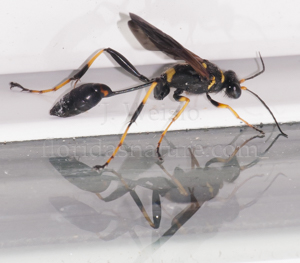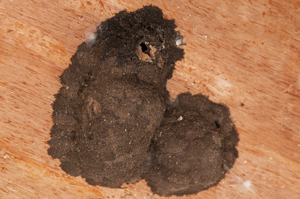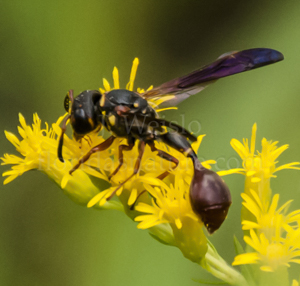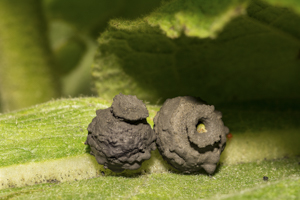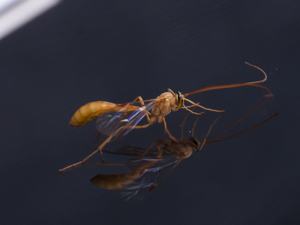Florida's Bees and Wasps
Bees and Wasps of Florida
Bees and wasps of the family Sphecidae (sand wasps, mud daubers, and other thread-waisted wasps) belong to the Super-family Apoidea.
Bees are believed to have evolved from wasp ancestry, as they share many common traits.
Of the 4,000 species of bees that are native to North America, there are about 315 species that are native to Florida, 29 of those species are endemic to Florida. (found only in Florida and nowhere else).
The importance of bees in crop pollination, wildflower and native plant reproduction and habitat sustainability is common knowledge.
Probably the most familiar bee is the Honey bee (Apis mellifera) the same species known as the European honey bee ( believed to have origins in Africa or Asia ), the honey bee has spread naturally to Europe and been introduced by humans to all other continents except Antarctica.
Florida has more than 320 bee species. There are over 4,000 species of bees in the U.S. and almost 20,000 species of bees worldwide. With a couple of exceptions all bees are pollinators though only a few species produce honey.
Many species of native bees are known as solitary bees, that is they do not live in colonies / hives, or cooperate in the gathering of food or rearing of young.
Native bees are often pollination specialists that evolved alongside specific types of plants and are the only insects capable of pollinating them. An estimated 30 percent of U.S. crops rely on native bees for pollination!
Western Honey Bee - Apis mellifera
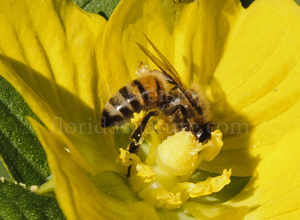
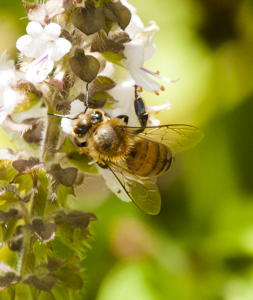
Family - Apidae
Honey Bees live in colonies of up to 80,000 individuals, they are widely domesticated for honey production and crop pollination and have been introduced to all continents except for Antarctica.
Honey bee colonies have one queen, the rest of the hive are female worker bees, with a couple hundred male drones during spring and summer, these drones are expelled from the hive in winter when food becomes scarce. Honey bees (workers) are between 3/8 inch to 3/4 of an inch in length, and have a life span up to five years.
Bumble Bees - Bombus spp.
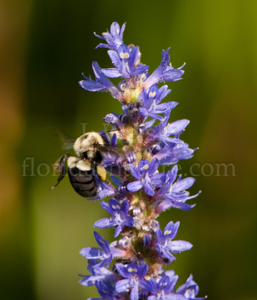
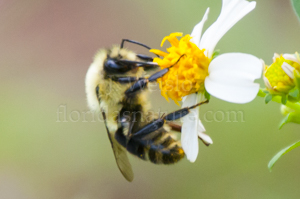
Family - Apidae
Another common bee is the Bumble bee, there are five species of Bumble bees present in Florida, pictured above is Bombus impatiens, the common Eastern bumble bee. This species can be found from Maine to Florida along the east coast of the U.S. and westward to Ohio.
Bumble bees are social bees and have annual nests consisting of up to five hundred individuals, the worker bees develop earliest followed by males and then new queens toward the end of summer. In fall all of them except for the new queens die off, these queens hibernate over winter emerging the following spring to find a suitable site to begin their new colonies.
Bumble bees in general are excellent pollinators and have been introduced to western portions of the U.S. and apparently overseas as well.
Southern Carpenter Bee - Xylocopa micans
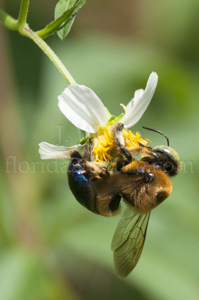
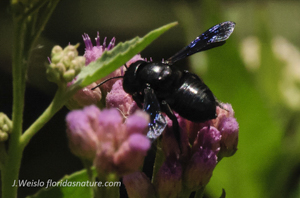
Family - Apidae
Subfamily - Xylocopinae
Southern carpenter bees are solitary bees, they do not live in a colony or co-habitat with others of its species. Females use their jaws to excavate holes in woody plant materials, boring a 8 mm. diameter hole in which she creates several brood cell chambers. Placing a ball of pollen mixed with nectar in each chamber as a food supply for the developing larvae, she then lays a single egg on each pollen/nectar ball. Sealing the chambers against intruders with wood pulp the queen then flies off, as these bees do not care for their young. Southern carpenter bees are 20mm. or about 3/4 of an inch long.
Family Megachilidae - Leaf cutter, Mason, and Resin Bees
Resin bees
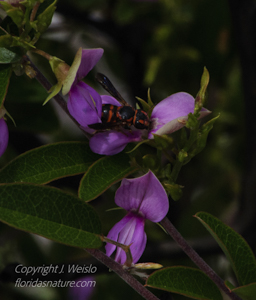
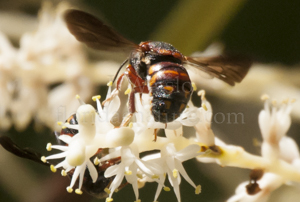
Nests of bees in this family consists of several chambers each chamber containing a pollen and nectar "loaf" and a single egg. Resin bees use plant resins with bits of wood, mud or small pebbles to construct and seal their brood chambers.
Similarly, Leaf-cutter bees use the bits of leaves they cut to construct a tube that is divided into several brood chambers.
Mason bees use soil for their nest, Carder and Wool-carder bees use plant fibers and animal hairs respectively, Pebble bees use pebbles cemented together with plant resins.
Leaf-cutter Bees
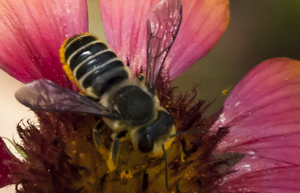

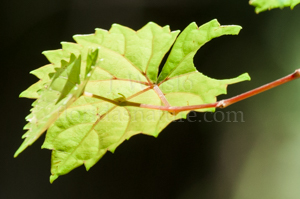
Leaf-cutter Bees cut semi-circular 1/4 inch to 1/2 inch pieces of thin, smooth leaves (as shown in the photo above) that are used to construct their nests in existing cavities, rotting wood or in plant stems that are either hollow or contain soft pithy centers that are easily excavated.
Leaf-cutter bees lack the pollen sacs, called Corbicula that honey bees and some other species of bees have on the tibia portion of their back legs to transport pollen. Instead these insects have fine hairs on the underside of their abdomen for that purpose, called Scopa these appear yellow/orange colored when holding pollen.
Say's Cuckoo-leaf-cutter bee - Coelioxys sayi
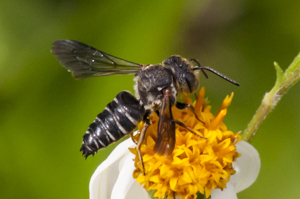
An example of Cleptoparasitic bees, commonly called "cuckoo bees" because their behavior is similar to cuckoo birds and they do not construct their own nests. They typically enter the nests of pollen collecting species, and lay their eggs in cells provisioned by the host bee. When the cuckoo bee larva hatches it consumes the host larva's pollen ball, and if the female bee has not already done so, kills and eats the host larva. In a few cases where the hosts are social species, the cleptoparasite remains in the host nest and lays many eggs, sometimes even killing the host queen and replacing her. Many cleptoparasitic bees are related to and closely resemble their hosts in looks and size.
Cellophane / Polyester Bees
Family - Colletidae
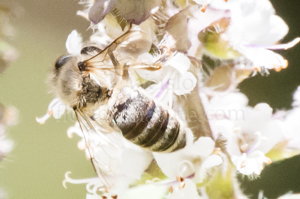
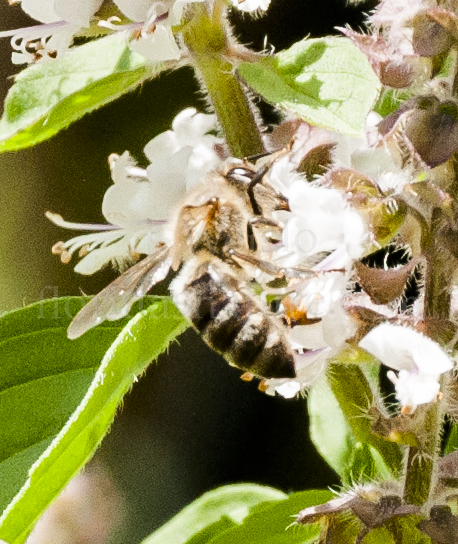
Cellophane bees are about the size of a Honey bee, with pale abdominal stripes, 7-15 mm long, these are solitary bees although they tend to nest in large aggregations.
Female Cellophane bees dig into the soil to make a tunnel, creating several brood chambers branching off from the main tunnel, each chamber is provisioned with a syrupy mixture of pollen and nectar and a single egg is laid close to it on the chamber wall.
To protect their larvae these amazing bees actually line their brood chambers with a clear, cellophane like substance said to be a type of polyester! This material is actually being studied by science as a biodegradable substitute for current plastics.
The cellophane lining for the nest allows the bees to nest in areas that would otherwise be too wet for nesting, it also provides protection against bacteria, fungus or mold.
Orchid Bee - Euglossa dilemma
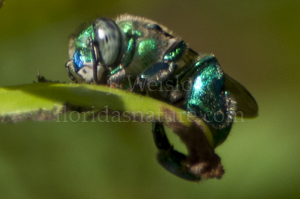

The Orchid bee was first found in Broward county in 2003, it is believed to have been brought here via a concealed nest imported from Mexico.
Orchid bees are solitary bees, although females may nest in close proximity to one another. Females construct nest cells in an enclosed cavity using plant resins collected for this purpose. Nests can contain up to 20 cells, each cell stocked with collected pollen and nectar as a food supply for the developing larvae.
Male Orchid bees collect fragrances from various flowers and store it within their hollow hind tibia. The male will actually disperse these fragrances later to attract females.
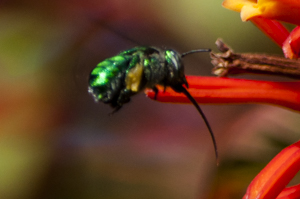
Genus Augochloropsis - Green Sweat Bees
Brown-winged Striped-Sweat bee - Agapostemon splendens
Family - Halictidae
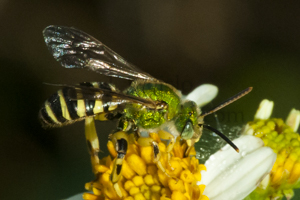
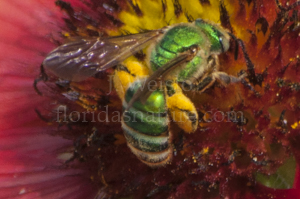
Above (L) Male (R) Female
These are solitary bees, 10-11 mm. long, or about the same size as a honey bee. Metallic green head and thorax, abdomen is striped with black and yellow bands , female abdomen is metallic green. Range - Montana to Arizona to Florida to Maine, Flights in Florida from April to October, with records in Florida of February, March and November. Usually nests in sandy soil or rotting wood. The sweat bees sting is reported as relatively mild.
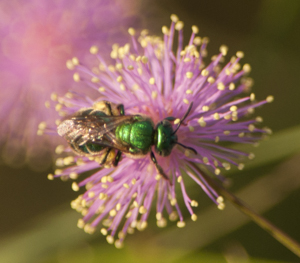
WASPS
With an estimated 18,000 species in North America wasps far outnumber the bees and are important to human agricultural endevors. Adult wasps feed only on sugars from fruits or flower nectar however they prey on various insects to feed their young. Without wasps we would soon be over run with pest insects, caterpillars, beetle grubs and grasshoppers.
Different species of wasps target different pests. Spider wasps hunt spiders, stinging and paralyzing them, then carrying the still living spider back to its nest as food for their larvae. Other wasps attach eggs on to or inject an egg into the host caterpillars and grubs, the resulting wasp larva then feeds on the host eventually killing it.
Wasps are also pollinators, transferring pollen from one flower to the next as they feed on pollen/nectar or hunt for prey
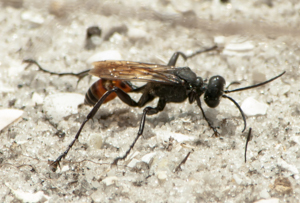
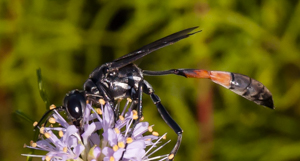
Pictured above are two wasps in the family Sphecidae ( above left ) is a species in the genus Prionyx that hunts adult grasshoppers as a food source for its larva. The wasp pictured (above right) is in the genus Ammophila this wasp hunts caterpillars and sawflies. Both are solitary wasps that dig burrows in sand in which they lay a single egg, then provisioning it with the aforementioned prey of choice. Often referred to as "digger wasps" or "sand wasps", these wasps prefer drier locations with sandy areas nearby. Adults feed on flower pollen.
Paper Wasps / Family - Vespidae
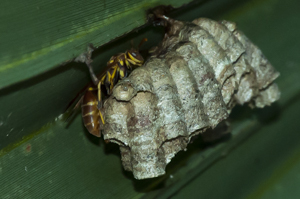

Above (L) Paper wasp nest (R) Red paper wasp
Paper wasps gather fibers from dry wood and dead plant materials to build their nests. They chew the fibers and mix them with saliva to create the paper used to construct their grey or brown colored paper nests.
Paper wasps are eusocial wasps, the queen building a nest containing many chambers arranged in an open ended honey-comb fashion. Female workers are foragers, and often leave the nest to hunt for food consisting mainly of caterpillars and leaf-hoppers. The workers engage in malaxation of their captured prey and drop off pieces into the larval cells, providing food for the growing larvae. Adults are unable to digest solid food.
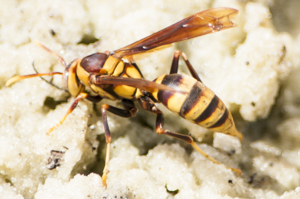
Above - Horse's Paper wasp (Polistes major major)
Parasitoid Wasps
Parasitoid wasps are wasps that lay their eggs on or in the bodies of other arthropods, butterfly or moth caterpillars being a common host, other wasp species use other insect hosts including beetles, bugs and flies. Wasps in the family Pompilidae prey specifically on spiders.
Some parasitoid wasps lay their eggs on the outside of the host (ectoparasitic) most of these species are "idiobiont" stinging and paralyzing the host to prevent the wasps eggs and larva from being dislodged or injured as the host moves around or during the moulting process.
Other wasps inject an egg inside of the host (endoparasitic). Most of these are "koinobiont", the egg is deposited at an early stage of the hosts life cycle and allows the host to further mature. Some endoparasitic wasps also inject a mixture of polydnaviruses that suppress the hosts immune system, along with ovarian proteins and venom.
These wasps are beneficial to humans playing an important role in controlling agricultural insect pests, many of these types of wasps have no sting or a mild sting.
Long-tailed Giant Ichneumon Wasp - Megarhyssa macrurus
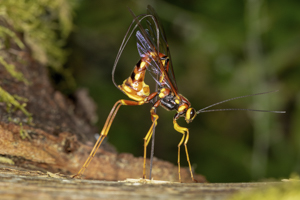
Harmless to humans, these are parasitoids on the larvae of the pigeon horntail (Tremex columba).
Great golden digger wasp - Sphex ichneumoneus
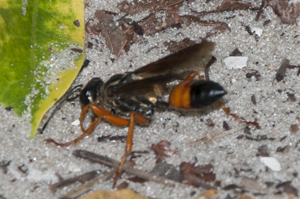
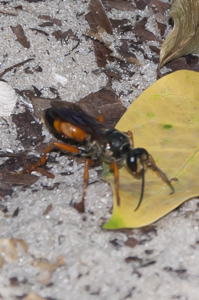
Common names include - Great Golden Sand-digger Wasp, North American Great Golden Digger Wasp.
As its name implies this wasp also digs a burrow to nest in, digging a vertical shaft with brood chambers dug horizontally out from it. This wasp preys upon various members of the order Orthoptera, such as grasshoppers, crickets, and katydids to provision its nest with.
Alabagrus texanus
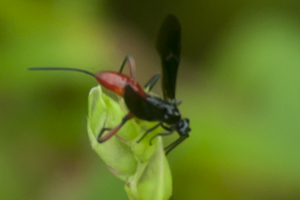
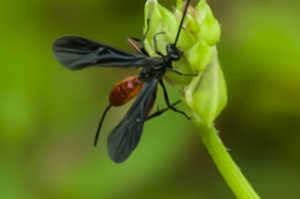
Preys on the caterpillar of the Cabbage Butterfly.
Wingless wasps, Velvet ants, Cow killer ants
(Family - Mutillidae)
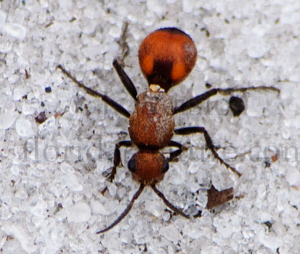
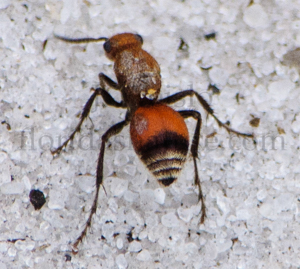
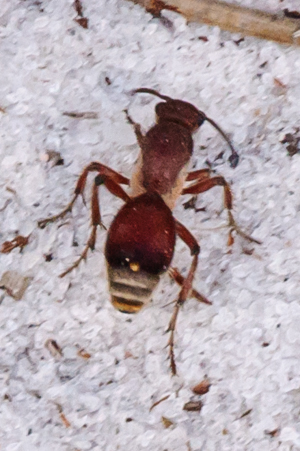
Commonly referred to as velvet ants or "cow killer" ants these are actually female wasps that do not have wings, 50 species of these wasps are found within Florida.
The severity of the sting reportedly varies significantly across the different species and among individuals of a species as well. The species Dasymutilla occidentalis in particular has earned the reputation as the "cow killer" with its particularly painful sting.
These wasps use bumble bees as a host species, depositing their eggs near the bees brood chamber, the wasps larvae kills and consumes the bee larvae, it then pupates in the brood chamber emerging from the nest as an adult wasp.
Beewolves
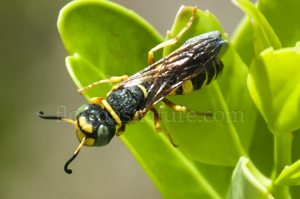
Philanthus ventilabris
Found throughout Florida and most of North America as far north as southern Canada, females of this wasp provision their nest with bees. This is a solitary species of wasp that is often found on or near flowers where they attack bees coming to feed.
Females burrow into the ground creating an underground cavity for their nest and stocking it with as many as half a dozen bees for their larvae to feed on, soil composition is especially important for this, soil that is too sandy collapses, hard packed soil makes burrowing impossible. Many species of beewolves (there are 32 species in N. America) prey mainly on sweat bees of the family Halictidae, adults feed on flower nectar.
